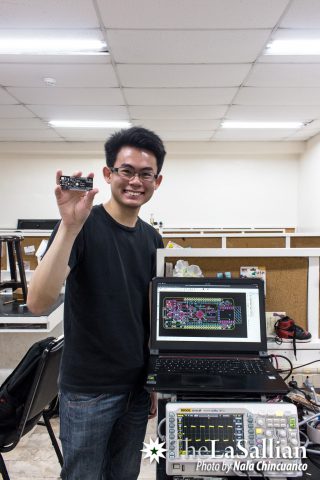For many makers, hobbyists, and engineers, the Arduino has been a household name since its early beginnings in 2005. From how intuitively easy it is to use in addition to all the versatile features that come along with the device, the Arduino—a software tool that aids programmers in building applications—is readily programmable via an integrated development environment and can be interfaced with a plethora of sensors, motors, and other input devices to produce projects from simple remote-controlled cars to complex home-automation systems.
But just like how devices are remodelled for performance and specifications upgrades, John Patrick “JP” Tan (CS-CSE, ‘18) conceptualized the Clouduino Stratus—the pioneer edition of the Clouduino line of boards—to do just that. The main difference that sets the Clouduino apart from the Arduino is that it utilizes the ESP8266—a microcontroller that has a built-in Wi-Fi subsystem. As a self-contained microchip with Wi-Fi abilities, the ESP8266 is able to perform most of its operations in hardware, processing data up to 170 times faster than the Arduino.
Inspiring innovation
In an interview with The LaSallian, Tan mentions the topic of the Philippines being globally recognized as a country teeming with Business Process Outsourcing companies and how it is the responsibility of the current generation of Filipino visionaries and innovators to rectify and angle perspectives toward a more innovation-oriented one—centered on fostering technology to stimulate development in communities.
Tan began his journey with the Clouduino during his internship days in Proudcloud, a full stack development firm based in the Philippines, when he was still a student of De La Salle University. Being exposed to microprocessor-based technologies and embedded systems back in college, he was immersed in different fields related to the multidisciplinary facets of computer systems engineering.
Initially dubbed as the “Proud board”, Tan’s internship in Proudcloud led to contemplating on inventing a microcontroller development board with Proudcloud Chief Technology Officer Erik Lacson, with the notion that something similar has not yet been done locally or in other Southeast Asian countries intrigued them both. “I wanted to start on this project because it was complex and interesting. It’s something that is not usually done during an internship,” Tan reveals.

Proudly Filipino
“I’m excited to work on projects that people might find not very typical [in] the [country’s setting]. It’s very important for us to show what the Philippines can do. Despite not having, perhaps, the same level of maturity when it comes to our electronics or manufacturing equipment or facilities, we have the skills and we have the talent to compete on the world stage,” Tan elaborates.
According to the Clouduino inventor, most attempts at manufacturing a development board in other Southeast Asian countries almost always end up being done in suboptimal environments, thus yielding substandard results. This, among other reasons, prompted him to push for the development of a microcontroller development board that would not only exhibit the technological capabilities of the Philippines, but also showcase the level that the country can operate at.
A scalable goal
Designing the board to scale optimally is still in question, as optimization and mass production are two of the main problems Tan and his team are currently facing.
According to the inventor, the goal is to have the device automated through optimizations for pick-and-place machines and reflow ovens—two machines that drastically improve the speed of production with great accuracy. “You might be making maybe hundreds or thousands using pick-and-place machines and reflow ovens. That will necessitate additional design changes so we could optimize the pick-and-place machine we’re using and the reflow oven we have. That’s part of the engineering perspective; optimizing how many of those things [we can] make on a single panel, on the PCB, and optimizing for that,” he remarks.
For the community, by the community
Though no pricing has yet been laid out, the board and software will not be patented and will be open-sourced, which will help iron out the current bugs and for others to contribute to the design of the board.
“No part of it will be held back [from] the community, so anyone could just take the design. If you don’t have the money to buy it, you can just replicate it. Have it [fabricated] and boom, you have a board,“ Tan explains.
Currently, the Clouduino project is uploaded and maintained on Github—a website where professional programmers and amateurs alike upload their programs—so that others may use it; within it are the schematics and steps on building the board.
Moving forward, the Clouduino is one of many projects that Tan is working on, and much like the Clouduino, they will be open-sourced and locally-made.“[It] is actually just one of several projects that we envisioned. Others would include a single board computer, sort of like the Raspberry Pi. That’s definitely never been done locally. Let alone, some in other countries nearby. So, definitely, when we accomplish that, [it will be] a big thing,” Tan concludes
